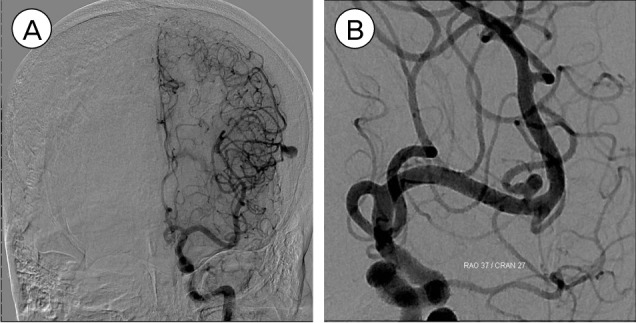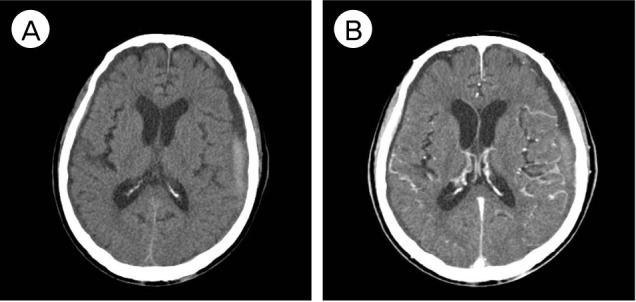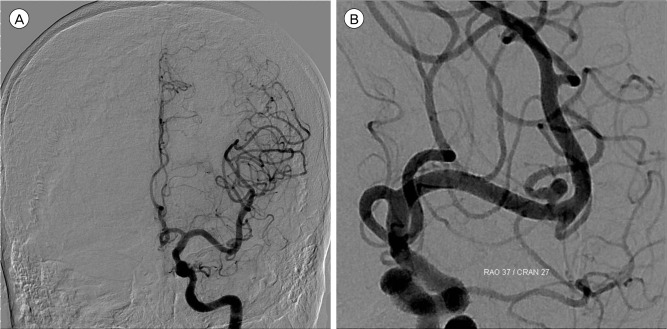J Cerebrovasc Endovasc Neurosurg.
2013 Sep;15(3):235-240. 10.7461/jcen.2013.15.3.235.
Ruptured Mycotic Aneurysm of the Distal Middle Cerebral Artery Manifesting as Subacute Subdural Hematoma
- Affiliations
-
- 1Department of Neurosurgery, Busan-Ulsan Regional Cardiocerebrovascular Center, Medical Science Research Center, College of Medicine, Dong-A University, Busan, Korea. jthuh@dau.ac.kr
- KMID: 1491445
- DOI: http://doi.org/10.7461/jcen.2013.15.3.235
Abstract
- Mycotic aneurysms are rare inflammatory neurovascular lesions. Ruptured mycotic aneurysm manifesting as subdural hematoma is extremely rare. A 72-year-old male patient was admitted to our hospital with headache and drowsiness. Computer tomography (CT) of brain and CT angiography revealed subdural hematoma and an aneurysm located at the M4 segment of the left middle cerebral artery (MCA). Cerebral angiogram revealed 2 aneurysms; one located at the left distal MCA and the other at the bifurcation of left MCA. Laboratory studies showed leukocytosis and elevated inflammatory factors. The patent was treated with antibiotic therapy for 4 weeks. The follow-up CT and cerebral angiography showed that the mycotic aneurysm was completely resolved, and the patient was nearly free of symptoms.
MeSH Terms
Figure
Reference
-
1. Ducruet AF, Hickman ZL, Zacharia BE, Narula R, Grobelny BT, Gorski J, et al. Intracranial infectious aneurysms: A comprehensive review. Neurosurg Rev. 2010; 1. 33(1):37–46. PMID: 19838745.
Article2. Bamford J, Hodges J, Warlow C. Late rupture of a mycotic aneurysm after cure of bacterial endocarditis. J Neurol. 1986; 2. 233(1):51–53. PMID: 3754002.
Article3. Bandoh K, Sugimura J, Hosaka Y, Takagi S. Ruptured intracranial mycotic aneurysm associated with acute subdural hematoma - Case report. Neurol Med Chir (Tokyo). 1987; 1. 27(1):56–59. PMID: 2441289.4. Barami K, Ko K. Ruptured mycotic aneurysm presenting as an intraparenchymal hemorrhage and nonadjacent acute subdural hematoma, case report and review of the literature. Surg Neurol. 1994; 4. 41(4):290–293. PMID: 8165497.
Article5. Bartakke S, Kabde U, Muranjan MN, Bavdekar SB. Mycotic aneurysm: An common cause for intra-cranial hemorrhage. Indian J Pediatr. 2002; 10. 69(10):905–907. PMID: 12450304.6. Bohmfalk GL, Story JL, Wissinger JP, Brown WE Jr. Bacterial intracranial aneurysm. J Neurosurg. 1978; 3. 48(3):369–382. PMID: 580294.
Article7. Bonow RO, Carabello BA, Chatterjee K, de Leon AC Jr, Faxon DP, Freed MD, et al. 2008 Focused update incorporated into the ACC/AHA 2006 Guidelines for the management of patients with valvular heart disease: A report of the American College of Cardiology/American Heart Association Task Force on Practice Guidelines (Writing Committee to Revise the 1998 Guidelines for the Management of Patients With Valvular Heart Disease): Endorsed by the Society of Cardiovascular Anesthesiologists, Society for Cardiovascular Angiography and Interventions, and Society of Thoracic Surgeons. Circulation. 2008; 10. 118(15):e523–e661. PMID: 18820172.
Article8. Frazee JG, Cahan LD, Winter J. Bacterial intracranial aneurysm. J Neurosurg. 1980; 11. 53(5):633–641. PMID: 6893602.9. Frazee JG. Inflammatory intracranial aneurysm. In : Wilikins RH, Rengachary SS, editors. Neurosurgery. New York: McGraw-Hill;1996. p. 2379–2382.10. Horstkotte D, Follath F, Gutschik E, Lengyel M, Oto A, Pavie A, et al. Guidelines on prevention, diagnosis and treatment of infective endocarditis executive summary; The task force on infective endocarditis of the European society of cardiology. Eur Heart J. 2004; 2. 25(3):267–276. PMID: 14972429.
Article11. Bederson JB, Meyer SA. Infectious intracranial aneurysm. In : Winn HR, editor. Youmans neurological surgery. 6th edition. Philadelphia, PA: Elsevier Saunders;2012. p. 3972–3977.12. Kannoth S, Thomas SV, Nair S, Sarma PS. Proposed diagnostic criteria for intracranial infectious aneurysms. J Neurol Neurosurg Psychiatry. 2008; 8. 79(8):943–946. PMID: 18303107.
Article13. Kasuya H, Shimizu T, Tajika T, Kitamura K, Okada N, Sugama M, et al. [A case of septic aneurysm complicated with simultaneous subdural and intracerebral hematoma]. No Shinkei Geka. 1985; 10. 13(10):1109–1113. Japanese. PMID: 3841193.14. King AB. Successful surgical treatment of an intracranial mycotic aneurysm complicated by a subdural hematoma. J Neurosurg. 1960; 7. 17:788–791. PMID: 14409147.
Article15. Matsuda T, Kiyosue H, Yamashita M, Tanoue S, Okahara M, Nagatomi H, et al. [A case of multiple mycotic intracranial aneurysms presenting with subdural hematoma]. No Shinkei Geka. 2002; 1. 30(1):73–78. Japanese. PMID: 11806111.16. Morawetz RB, Karp RB. Evolution and resolution of intracranial bacterial (mycotic) aneurysms. Neurosurgery. 1984; 7. 15(1):43–49. PMID: 6548001.
Article17. Osler W. The Gulstonian lectures, on malignant endocarditis. Br Med J. 1885; 3. 1(1262):467–470.
Article18. Peters PJ, Harrison T, Lennox JL. A dangerous dilemma: Management of infectious intracranial aneurysms complicating endocarditis. Lancet Infect Dis. 2006; 11. 6(11):742–748. PMID: 17067923.
Article19. Phuong LK, Link M, Wijdicks E. Management of intracranial infectious aneurysms: A series of 16 cases. Neurosurgery. 2002; 11. 51(5):1145–1151. discussion 1151-2. PMID: 12383359.
Article20. Piastra M, Chiaretti A, Tortorolo L. Ruptured intracranial mycotic aneurysm presenting as cerebral haemorrhage in an infant: Case report and review of the literature. Childs Nerv Syst. 2000; 3. 16(3):190–193. PMID: 10804057.
Article21. Pruitt AA, Rubin RH, Karchmer AW, Duncan GW. Neurologic complications of bacterial endocarditis. Medicine (Baltimore). 1978; 7. 57(4):329–343. PMID: 580794.
Article22. Sonneville R, Mirabel M, Hajage D, Tubach F, Vignon P, Perez P, et al. Neurologic complications and outcomes of infective endocarditis in critically ill patients: The ENDOcardite en REAnimation prospective multicenter study. Crit Care Med. 2011; 6. 39(6):1474–1481. PMID: 21358398.
Article23. Kannoth S, Thomas SV. Intracranial microbial aneurysm (Infectious aneurysm): Current options for diagnosis and management. Neurocrit Care. 2009; 11(1):120–129. PMID: 19322683.
Article24. Kannoth S, Iyer R, Thomas SV, Furtado SV, Rajesh BJ, Kesavadas C, et al. Intracranial infectious aneurysm: Presentation, management and outcome. J Neurol Sci. 2007; 5. 256(1-2):3–9. PMID: 17360002.
Article25. Sugg RM, Weir R, Vollmer DG, Cacayorin ED. Cerebral mycotic aneurysm treated with a neuroform stent: Technical case report. Neurosurgery. 2006; 2. 58(2):E381. discussion E381. PMID: 16462464.26. Sugino T, Yamamoto K, Kidooka M, Otsuka S. [A ruptured mycotic aneurysm, simultaneously associated with acute subdural hematoma and intracerebral hemorrhage: Case report and review of the literature]. No Shinkei Geka. 2002; 11. 30(11):1211–1215. Japanese. PMID: 12428355.27. Suzuki Y, Kawamata T, Omura M, Matsumoto K. [Multiple bacterial aneurysms: case report]. No Shinkei Geka. 1998; 4. 26(4):357–362. Japanese. PMID: 9592817.28. Tashima T, TakaKi T, Hikita T, Kuroiwa S, Hamanaka N, Takahashi M. [Bacterial intracranial aneurysm associated with infective endocarditis: A case showing enlargement of aneurysm size]. No Shinkei Geka. 1995; 11. 23(11):985–989. Japanese. PMID: 7477721.29. Theodore S, Unnikrishnan M, Neelakandhan KS. Extracranial carotid aneurysms in young patients. Ann Thorac Surg. 2006; 5. 81(5):1943. author reply 1943-4. PMID: 16631720.
Article30. Tice AD, Rehm SJ, Dalovisio JR, Bradley JS, Martinelli LP, Graham DR, et al. Practice guidelines for outpatient parenteral antimicrobial therapy. IDSA guidelines. Clin Infect Dis. 2004; 6. 38(12):1651–1672. PMID: 15227610.31. Tsuboi M, Adachi H. [A ruptured distal aneurysm, thought to be a mycotic aneurysm, associated with acute subdural hematoma: Case report and review of the literature]. No Shinkei Geka. 2002; 2. 30(2):177–181. Japanese. PMID: 11857942.32. Tunkel AR, Hartman BJ, Kaplan SL, Kaufman BA, Roos KL, Scheld WM, et al. Practice guidelines for the management of bacterial meningitis. Clin Infect Dis. 2004; 11. 39(9):1267–1284. PMID: 15494903.
Article33. Wakamoto H, Tomita H, Miyazaki H, Ishiyama N, Akasaka Y. [The early hemorrhage and development of a bacterial aneurysm after a cerebral ischemic attack caused by a septic embolism - A case report]. No Shinkei Geka. 2001; 5. 29(5):415–420. Japanese. PMID: 11449712.34. Yamakawa H, Hattori T, Tanigawara T, Enomoto Y, Ohkuma A. Ruptured infectious aneurysm of the distal middle cerebral artery manifesting as intracerebral hemorrhage and acute subdural hemorrhage - Case Report. Neurol Med Chir (Tokyo). 2003; 11. 43(11):541–545. PMID: 14705320.
- Full Text Links
- Actions
-
Cited
- CITED
-
- Close
- Share
- Similar articles
-
- Subdural Hematoma Due to Ruptured Intracerebral Aneurysm
- A Middle Cerebral Mycotic Aneurysm Ruptured into the Lateral Ventricle
- Subdural Hematoma without Subarachnoid Hemorrhage Caused by the Rupture of Middle Cerebral Artery Aneurysm
- Pure Acute Subdural Hematoma without Subarachnoid Haemorrhage Caused by Rupture of Distal Anterior Cerebral Artery Aneurysm
- Coil Embolization for Distal Middle Cerebral Artery Aneurysm





